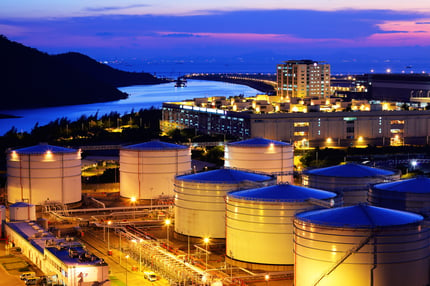According to the Kansas Geological Survey, over 1,000 earthquakes occur across the world. Over the year 2020, 260 earthquakes were in Kansas - about 50 of them in El Dorado. However, earthquakes under 2.5 magnitude usually aren't felt; that's why it doesn't seem that we're shaking constantly, as most of those 1,000 earthquakes fall below 2.0 magnitude. Structural damage doesn't even start until 5.5 magnitude - Kansas' two strongest earthquakes both peaked at 5.1 and 5.2.
 Andrew Swindle, an associate professor at the Department of Geology at Wichita State University, elaborated on this.
Andrew Swindle, an associate professor at the Department of Geology at Wichita State University, elaborated on this.
"Even with a 5 to 5.5," Swindle says, "it's gonna depend how close you are, how deep the earthquake is, and the geologic conditions."
But the KGS has been tracking an increase in earthquakes and their strength in Kansas since 2013; why?
Earthquakes are usually caused by shifting tectonic plates under Earth's surface. The biggest fault line in America, where these plates clash the most often, is along the West Coast - California and other states seeing the most seismic activity in the country. Outside of the tectonic plate activity, earthquakes can be triggered by the erosion and deposition of surface rock, as well as other geological processes that create pressure below the Earth that needs to be released.
Kansas is notable for having the Nemaha Ridge, a buried mountain range that stretches from Oklahoma City, Oklahoma up to Omaha, Nebraska. It cuts very close to Wichita and El Dorado. Since it's peppered in smaller faults, it's been known to cause some of the earthquakes in Kansas - particularly in our local area. A string of earthquakes, mostly aftershocks, that occurred in 2020 as well as 2016 were linked to natural activities from this ridge.
But over the natural activities within the Earth, the most common cause for earthquakes in the Midwest is horizontal drilling, hydraulic fracturing and wastewater disposal. These activities became much more frequent after 2013, the start of Kansas' increase of earthquakes.
According to the Encyclopedia of Energy, horizontal drilling is "a process of directing a bit to drill along a horizontal path", drilling at roughly a right angle. It can stimulate reservoir of oil and gas, as well as gather more information than continuing to dig straight down, according to the Shale Oil and Gas Handbook. Hydraulic fracking, meanwhile, is using pressurized water to break into bedrock formation and find these reservoirs. Together, these are frequently referred to as "fracking." It has only caused a few felt earthquakes worldwide, and the largest earthquake that can be traced to the process was a 3.9 magnitude one in Oklahoma back in 2019, according to the United States Geological Survey.
But wastewater disposal is a bit of a different story.
Wastewater disposal is when the large amount of contaminated water created by these procedures is injected into the empty wells left after the processes have finished. This is so it doesn't contaminate drinking water.
"The formations they're injecting into are way before the usable water table," Swindle says. "So, the only way there would be interaction would be if there were some sort of mechanical failure of the well itself - something would have to break, because there's usually thousands of feet of rock in between where the usable water is and where they're injecting the wastewater."
It is also the most frequent to blame for large earthquakes. Swindle elaborated on why.
"One thing to be clear about is that the mechanism by which wastewater injection wells could induce seismic activity, the idea that's currently accepted, is not that these wells are injecting under such a high pressure that it's making the ground shake," Swindle explains. "The ground is already stressed. There's faults underground from previous geological episodes, it's just that they're buried under tons of rock, so the friction keeps them locked in place. When we're injecting all this fluid, the fluid is lubricating all these faults and allowing them to slip, which is what's triggering the earthquakes."
But wastewater disposal directly changes pressures underneath the earth and can erode the rocks around it, causing earthquakes or encouraging them.
The "PBS News Hour" reported that wastewater injection can cause earthquakes far from the injection well, due to the water injected into the ground slipping towards other faults and causing them to loosen up. The largest earthquake that can be traced back to the wastewater injection was a 5.8 earthquake in 2016, in central Oklahoma.
The combination of the earthquake increase aligning with the increase in fracking and wastewater disposal, with most of these stronger earthquakes occurring near drilling operations in southern Kansas, pins the blame fairly solidly in the operations. What does that mean for the rest of the state?
The Kansas Geological Society doesn't know if increased seismic activity like this will raise the state's long-term risk for earthquakes. When an earthquake over 3.5 magnitude occurs, the KGS and Kansas Department of Health and Environment will investigate wells and drilling activity within a radius of the area, making sure they meet permit conditions. But they can't outright prevent an earthquake.
"I don't think the earthquakes themselves will be big enough that they will cause structure damage... They could exacerbate any structural issues, buildings that have enough cracks in them. There could be enough vibrations that would make those a little worse, but I don't think we're gonna be knocking any buildings over," Swindle says.
Kansas has earned its reputation for rough weather, but it doesn't look like it will be picking up one for destructive earthquakes anytime soon. Only cracked plaster and the occasional fallen object.
VIEW COMMENTS